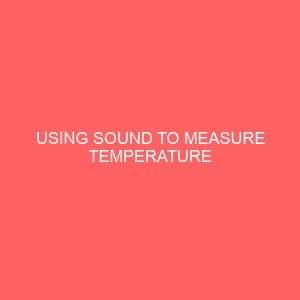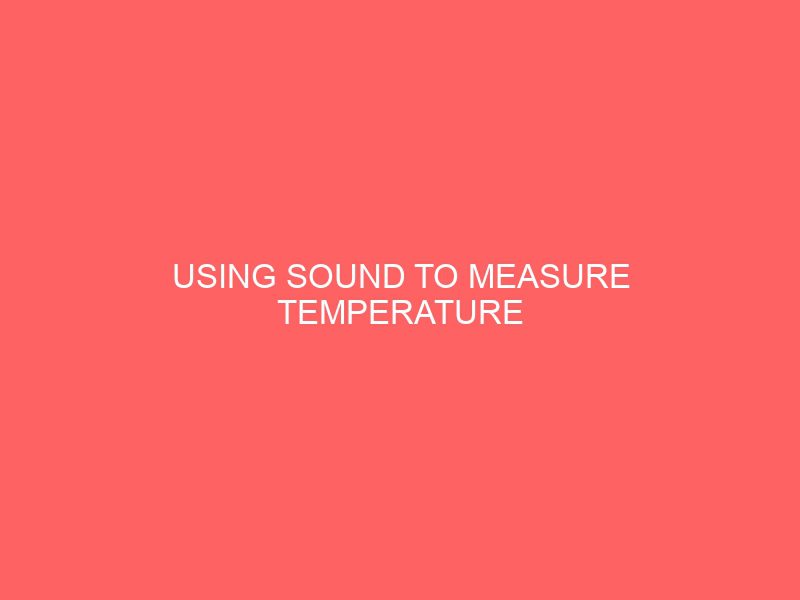Description
CHAPTER ONE
1.0 INTRODUCTION
This research is on using sound to measure temperature. A temperature is an objective comparative measure of hot or cold. It is measured by a thermometer, which may work through the bulk behavior of a thermometric material, detection of thermal radiation , or particle kinetic energy Several scales and units exist for measuring temperature, the most common being Celsius denoted C; formerly called centigrade, Fahrenheit denoted F, and, especially in science, Kelvin denoted K.
The coldest theoretical temperature is absolute zero, at which the thermal motion in matter would be zero. However, an actual physical system or object can never attain a temperature of absolute zero. Absolute zero is denoted as 0 K on the Kelvin scale, 273.15 C on the Celsius scale, and 459.67 F on the Fahrenheit scale.
The kinetic theory offers a valuable but limited account of the behavior of the materials of macroscopic systems, especially of fluids. It indicates the absolute temperature as proportional to the average kinetic energy of the random microscopic motions of their constituent microscopic particles such as electrons, atoms, and molecules.
Temperature is important in all fields of natural science, including physics, geology, chemistry, atmospheric sciences, medicine , and biology as well as most aspects of daily life. Many physical processes are affected by temperature, such as physical properties of materials including the phase solid , liquid , gaseous or plasma, density , solubility, vapor pressure , electrical conductivity rate and extent to which chemical reactions occur the amount and properties of thermal radiation emitted from the surface of an object speed of sound is a function of the square root of the absolute temperature.
Temperature scales differ in two ways: the point chosen as zero degrees, and the magnitudes of incremental units or degrees on the scale.
The Celsius scale C is used for common temperature measurements in most of the world. It is an empirical scale. It developed by a historical progress, which led to its zero point 0 C being defined by the freezing point of water, with additional degrees defined so that 100 C was the boiling point of water, both at sea level atmospheric pressure. Because of the 100 degree interval, it is called a centigrade scale. 1 Since the standardization of the kelvin in the International System of Units, it has subsequently been redefined in terms of the equivalent fixing points on the Kelvin scale, and so that a temperature increment of one degree Celsius is the same as an increment of one kelvin, though they differ by an additive offset of 273.15.
The United States commonly uses the Fahrenheit scale, on which water freezes at 32 F and boils at 212 F at sea level atmospheric pressure.
Many scientific measurements use the kelvin temperature scale unit symbol K, named in honor of the Scottish physicist who first defined it. It is a thermodynamic or absolute temperature scale. Its zero point, 0 K, is defined to coincide with coldest physically possible temperature called absolute zero. Its degrees are defined through thermodynamics. The temperature of absolute zero occurs at 0 K 273.15 C or 459.67 F, and the freezing point of water at sea level atmospheric pressure occurs at 273.15 K 0 C.
The International System of Units SI defines a scale and unit for the kelvin or thermodynamic temperature by using the reliably reproducible temperature of the triple point of water as a second reference point the first reference point being 0 K at absolute zero. The triple point is a singular state with its own unique and invariant temperature and pressure, along with, for a fixed mass of water in a vessel of fixed volume, an autonomically and stably self determining partition into three mutually contacting phases, vapour, liquid, and solid, dynamically depending only on the total internal energy of the mass of water. For historical reasons, the triple point temperature of water is fixed at 273.16 units of the measurement increment.
In physics, sound is a vibration that propagates as a typically audible mechanical wave of pressure and displacement, through a medium such as air or water. In physiology and psychology, sound is the reception of such waves and their perception by the brain.
Sound can propagate through compressible media such as air, water and solids as longitudinal waves and also as a transverse waves in solids see Longitudinal and transverse waves, below. The sound waves are generated by a sound source, such as the vibrating diaphragm of a stereo speaker. The sound source creates vibrations in the surrounding medium. As the source continues to vibrate the medium, the vibrations propagate away from the source at the speed of sound, thus forming the sound wave. At a fixed distance from the source, the pressure, velocity, and displacement of the medium vary in time. At an instant in time, the pressure, velocity, and displacement vary in space. Note that the particles of the medium do not travel with the sound wave. This is intuitively obvious for a solid, and the same is true for liquids and gases that is, the vibrations of particles in the gas or liquid transport the vibrations, while the average position of the particles over time does not change. During propagation, waves can be reflected, refracted, or attenuated by the medium.
The behaviour of sound propagation is generally affected by three things:
- A relationship between density and pressure this relationship, affected by temperature, determines the speed of sound within the medium.
- The propagation is also affected by the motion of the medium itself. For example, sound moving through wind. Independent of the motion of sound through the medium, if the medium is moving, the sound is further transported.
- The viscosity of the medium also affects the motion of sound waves. It determines the rate at which sound is attenuated. For many media, such as air or water, attenuation due to viscosity is negligible.
When sound is moving through a medium that does not have constant physical properties, it may be refracted either dispersed or focused.
1.1 BACKGROUND OF THE STUDY:
A temperature is an objective comparative measure of hot or cold. It is measured by a thermometer, which may work through the bulk behavior of a thermometric material, detection of thermal radiation , or particle kinetic energy Several scales and units exist for measuring temperature, the most common being Celsius denoted C; formerly called centigrade, Fahrenheit denoted F, and, especially in science, Kelvin denoted K.
The coldest theoretical temperature is absolute zero, at which the thermal motion in matter would be zero. However, an actual physical system or object can never attain a temperature of absolute zero. Absolute zero is denoted as 0 K on the Kelvin scale, 273.15 C on the Celsius scale, and 459.67 F on the Fahrenheit scale.
The kinetic theory offers a valuable but limited account of the behavior of the materials of macroscopic systems, especially of fluids. It indicates the absolute temperature as proportional to the average kinetic energy of the random microscopic motions of their constituent microscopic particles such as electrons, atoms, and molecules.
Temperature is important in all fields of natural science, including physics, geology, chemistry, atmospheric sciences, medicine , and biology as well as most aspects of daily life. Many physical processes are affected by temperature, such as physical properties of materials including the phase solid , liquid , gaseous or plasma, density , solubility, vapor pressure , electrical conductivity rate and extent to which chemical reactions occur the amount and properties of thermal radiation emitted from the surface of an object speed of sound is a function of the square root of the absolute temperature.
Temperature scales differ in two ways: the point chosen as zero degrees, and the magnitudes of incremental units or degrees on the scale.
The Celsius scale C is used for common temperature measurements in most of the world. It is an empirical scale. It developed by a historical progress, which led to its zero point 0 C being defined by the freezing point of water, with additional degrees defined so that 100 C was the boiling point of water, both at sea level atmospheric pressure. Because of the 100 degree interval, it is called a centigrade scale. 1 Since the standardization of the kelvin in the International System of Units, it has subsequently been redefined in terms of the equivalent fixing points on the Kelvin scale, and so that a temperature increment of one degree Celsius is the same as an increment of one kelvin, though they differ by an additive offset of 273.15.
The United States commonly uses the Fahrenheit scale, on which water freezes at 32 F and boils at 212 F at sea level atmospheric pressure.
Many scientific measurements use the kelvin temperature scale unit symbol K, named in honor of the Scottish physicist who first defined it. It is a thermodynamic or absolute temperature scale. Its zero point, 0 K, is defined to coincide with coldest physically possible temperature called absolute zero. Its degrees are defined through thermodynamics. The temperature of absolute zero occurs at 0 K 273.15 C or 459.67 F, and the freezing point of water at sea level atmospheric pressure occurs at 273.15 K 0 C.
The International System of Units SI defines a scale and unit for the kelvin or thermodynamic temperature by using the reliably reproducible temperature of the triple point of water as a second reference point the first reference point being 0 K at absolute zero. The triple point is a singular state with its own unique and invariant temperature and pressure, along with, for a fixed mass of water in a vessel of fixed volume, an autonomically and stably self determining partition into three mutually contacting phases, vapour, liquid, and solid, dynamically depending only on the total internal energy of the mass of water. For historical reasons, the triple point temperature of water is fixed at 273.16 units of the measurement increment.
In physics, sound is a vibration that propagates as a typically audible mechanical wave of pressure and displacement, through a medium such as air or water. In physiology and psychology, sound is the reception of such waves and their perception by the brain.
Sound can propagate through compressible media such as air, water and solids as longitudinal waves and also as a transverse waves in solids see Longitudinal and transverse waves, below. The sound waves are generated by a sound source, such as the vibrating diaphragm of a stereo speaker. The sound source creates vibrations in the surrounding medium. As the source continues to vibrate the medium, the vibrations propagate away from the source at the speed of sound, thus forming the sound wave. At a fixed distance from the source, the pressure, velocity, and displacement of the medium vary in time. At an instant in time, the pressure, velocity, and displacement vary in space. Note that the particles of the medium do not travel with the sound wave. This is intuitively obvious for a solid, and the same is true for liquids and gases that is, the vibrations of particles in the gas or liquid transport the vibrations, while the average position of the particles over time does not change. During propagation, waves can be reflected, refracted, or attenuated by the medium.
The behaviour of sound propagation is generally affected by three things:
A relationship between density and pressure this relationship, affected by temperature, determines the speed of sound within the medium.
The propagation is also affected by the motion of the medium itself. For example, sound moving through wind. Independent of the motion of sound through the medium, if the medium is moving, the sound is further transported.
The viscosity of the medium also affects the motion of sound waves. It determines the rate at which sound is attenuated. For many media, such as air or water, attenuation due to viscosity is negligible.
When sound is moving through a medium that does not have constant physical properties, it may be refracted either dispersed or focused.
1.2.STATEMENT OF PROBLEM:
The following forms the problems that necessitated the research of this project work;
- The lapses found with other means of measuring temperature.
- The difficulties involved in using other means of measuring temperature.
- The high cost of other means of measuring temperature.
1.3 OBJECTIVE OF THE STUDY:
The following forms the objective of this study:
- To show that the use of sound for the measurement of temperature is faster and more accurate than the other methods already known.
- To determine temperature by measuring the speed of sound in air.
- To minimize the cost of measuring temperature using the other methods that are expensive by introducing the measurement of temperature using sound.
1.4 SIGNIFICANCE OF THE STUDY:
The significance of this study is focused on its intent to portrait the essence of measuring temperature using sound through showing its speed, accuracy, reliability etc. this was achieved by using air as an example. Here, the temperature of air was measured by measuring the speed of sound in air.
1.5 SCOPE OF THE STUDY:
This project work only covers the measurement of temperature using sound where an example was sited using the measurement of the temperature of air using sound. This was achieved by measuring the speed of sound in air. The researcher therefore wishes to state that at the time of this research, the topic sited on the cover page was researched. Any other discovery made or not covered by this research should be assumed to be beyond the scope of this study.








Reviews
There are no reviews yet.